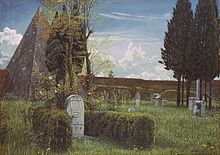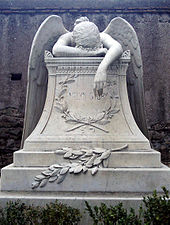Protestant cemetery (Rome)
The Protestant Cemetery (Italian Cimitero acattolico , also Cimitero degli Inglesi or Cimitero dei protestanti ) is one of the famous cemeteries in Rome .
The Cimitero acattolico is located in the Testaccio district at 6 Via Caio Cestio, near Porta San Paolo and the Pyramid of Cestius .
history
With the emergence of the longing for Italy , foreigners who were not of the Catholic faith came increasingly to Rome from the 18th century , especially English and German. If these died in Rome, they were not allowed to be buried in the general cemeteries that were reserved for Catholics or, in certain sections, for people of Jewish faith , such as the Campo di Verano . For those deceased foreigners, the non-Catholic cemetery was officially established in 1821 as Cimitero degli stranieri acattolici (Cemetery of Non-Catholic Foreigners) . The “Cimitero acattolico” is also a burial place for non-Catholic Italians and their relatives who have already been buried there. For example, Antonio Gramsci is buried here.
John Keats , who died in 1821, and Percy Bysshe Shelley , who drowned in 1822, were among the first famous people to be buried here. However, the first burials in the field behind the Cestius pyramid - outside the city, on the "Prati del popolo romano" ("Meadows of the Roman people)" - took place as early as 1732, so that this burial site can be found on the map of Nolli 1748 for the Protestants is named. The papal administration only allowed night funerals. This regulation, as well as the ban on the use of grave crosses, were in effect until the end of the Papal States in 1870.

Two such nocturnal burials were those of the little sons of the Prussian ambassador Wilhelm von Humboldt : Wilhelm was buried in 1803, and in 1807 his younger brother Friedrich Konstantin Gustav. These graves, which are located in the oldest part of the cemetery, in the “parte antica” near the Cestius pyramid , are located on the grave site that von Humboldt acquired from the city administration for his family after the death of his sons. Later Protestant diplomats at the papal court asked in vain for permission to fence in the cemetery to protect the graves. However, the area adjoining to the east, today's "zona vecchia", was made available for the enlargement of the cemetery with permission to enclose it. The wall around the parte antica was only built after the end of the Papal States. The expansion of the cemetery to its present size came about through the purchase of the land adjacent to the east on the old city wall, which thus forms the back of the cemetery, by the embassy of the German Reich in 1894. This area is divided into three parts, the sectors are named "Zona prima", "Zona seconda" and "Zona terza". The chapel was built in 1898. From 1871 until the end of the First World War, the cemetery was administered by the ambassador of the German Reich, then by a committee made up of diplomats from various countries.
Today the cemetery is open to visitors, who can visit the - sometimes pompous - crypts and tombs decorated with sculptures. In order to avoid tasteless designs, all drafts of grave monuments must be submitted to the cemetery administration.
A special feature of this cemetery are the many cats living between the graves, which are regularly supplied with food by volunteers. In order to be able to look after the tombs and their periphery, some of which are over 200 years old, the cemetery depends on donations from visitors.
Well-known personalities buried in the cemetery




The following famous people are buried in the cemetery:
- Walter Amelung (1865–1927), German archaeologist
- Hendrik Christian Andersen (1872–1940), Norwegian sculptor
- Robert Michael Ballantyne (1825-1894), Scottish writer
- Dario Bellezza (1944–1996), Italian poet
- Karl Julius Beloch (1854–1929), German ancient historian
- Peter Berling (1934–2017), German author and actor
- Emil Braun (1809–1856), German classical archaeologist
- Johan Bravo (1796–1876), German-Danish painter and consul
- Karl Brjullow (1799-1852), Russian painter
- Leo Bruhns (1884–1957), German art historian
- Otto von Bülow (1827–1901), German diplomat
- Johann Jürgen Busch (1758–1820), German sculptor
- Andrea Camilleri (1925-2019), Italian writer
- Asmus Carstens (1754–1798), German painter
- Jesse Benedict Carter (1872–1917), American classical philologist and religious scholar
- Gregory Corso (1930-2001), American poet
- Caesar von Dachröden (1808–1882), German director and court marshal
- Richard Henry Dana, Jr. (1815–1882), American lawyer, politician, and writer
- Esther Van Deman , (1862–1937), American archaeologist
- Clotilde von Derp , (1892–1974), German dancer
- Adam Eberle (1804–1832), German history painter and lithographer
- Friedrich August Elsasser (1810–1845), German painter
- Karl Philipp Fohr (1795–1818), German painter
- Johann Jakob Frey (1813–1865), Swiss landscape painter; Ferdinand Schlöth's tomb
- Carlo Emilio Gadda (1893–1973) Italian writer
- John Gibson (1790–1866), English sculptor
- August von Goethe (1789–1830), son of Johann Wolfgang von Goethe
- Antonio Gramsci (1891–1937), Italian philosopher
- William Stanley Haseltine (1835–1900), American landscape painter
- Helga von Heintze (1919–1996), German classical archaeologist
- Henriette Hertz (1846–1913), German art collector and patron, founder of the Bibliotheca Hertziana
- Christopher Hewetson (1739–1798), Irish sculptor
- Ingeborg Hoffmann (1921–1985), German actress, wife of Michael Ende
- Wilhelm Hopfgarten (1789–1860), German bronze caster (522 Zona Prima)
- William Howitt (1792–1879) and Mary Howitt (1799–1888), British writers
- Vyacheslav Ivanov (1866–1949), Russian philologist, poet and author
- Gualtiero Jacopetti (1919–2011), Italian director of documentaries
- Harald Jerichau (1851–1878), Danish painter
- John Keats (1795–1821), one of the most important poets of English Romanticism
- August Kestner (1777–1853), German diplomat and art collector
- Adolf Klügmann (1837–1880), German classical archaeologist
- Richard Krautheimer (1897–1994), German-American art historian
- Trude Krautheimer-Hess (1902–1987), German-American art historian
- Heinrich Kümmel (1810–1855), sculptor from Hanover
- Erwin Küsthardt (1867–1901), German painter and sculptor
- Belinda Lee (1935–1961), English actress
- Wolfgang Lotz (1912–1981), German art historian
- Hilde Lotz-Bauer (1907–1999), German photographer and art historian
- Hans von Marées (1837–1887), German painter
- George Perkins Marsh (1801-1882), American statesman and writer
- Malwida von Meysenbug (1816–1903), German writer
- Eduard Müller (1828–1895) and his twin brother Gustav Müller (1828–1901), on the stone it says "United in death"
- Egerton Herbert Norman (1909–1957), Canadian Japanologist and diplomat
- Friedrich von Ompteda (1770–1819), Hanoverian envoy to the Holy See
- August Wilhelm Pauli (1781–1858), German-Danish merchant and Hanseatic envoy in Copenhagen
- Milena Pavlović-Barili (1909–1945), Yugoslav painter and poet
- Max Peiffer-Watenphul (1896–1976), German painter
- Bruno Pontecorvo (1913–1993), Italian physicist
- Sarah Parker Remond (1826–1894), American doctor and opponent of slavery
- Frederick Reinhardt (1911–1971), US ambassador
- Johann Christian Reinhart (1761–1847), German painter and picture engraver
- Heinrich Reinhold (1788–1825), German painter
- Gisela MA Richter (1882–1972), American classical archaeologist
- Amelia Rosselli (1930–1996), Italian writer
- Alexander Sacharoff (1886–1963), Russian dancer and choreographer
- Renato Salvatori (1933–1988), Italian actor
- Helene Scholz-Zelezny (1882–1974), Austrian sculptor and medalist
- Gottfried Semper (1803–1879), German architect
- Joseph Severn (1793–1879), English painter
- Percy Bysshe Shelley (1792-1822), English writer
- Franklin Simmons (1839–1913), American sculptor and painter
- Maja Sprenger (1944–1976), German archaeologist
- William Wetmore Story (1819–1895), American sculptor and poet, and his wife Emelyn (1820–1895)
- Alexander Alexandrowitsch Swedomski (1848–1911), Russian painter
- Pawel Alexandrowitsch Swedomski (1849–1904), Russian painter
- John Addington Symonds (1840-1893), English author
- Johannes Toepffer (1860–1895), German ancient historian
- Elihu Vedder (1836–1923), American painter
- Wilhelm Waiblinger (1804-1830), German poet
- Friedrich Adolf von Willisen (1798–1864), Prussian general, protector of this cemetery as envoy from Prussia to the Holy See
- Søren Seidelin Winther (1810–1847), Danish sculptor and ivory carver
- Constance Fenimore Woolson (1840-1894), American writer
- Julius Zielke (1826–1907), German landscape and vedute painter
The graves of two children of Wilhelm von Humboldt , who was the Prussian ambassador to Rome at the time, are also in the cemetery: that of his eldest son Wilhelm (1794–1803) and that of his younger brother Friedrich Konstantin Gustav (1806–1807).
literature
- Johan Beck-Friis: Il Cimitero acattolico di Roma / The “Protestant Cemetery” in Rome . Malmö 1956 and several new editions, then Rome 1991.
- Helmut Zimmermann: Hanoverian graves in the Protestant cemetery in Rome . In: Hannoversche Geschichtsblätter . NF Vol. 9 (1955), pp. 131-162.
- Nicholas Stanley-Price, The Non-Catholic Cemetery in Rome, ed. The Non-Catholic Cemetery in Rome, Rome 2014, ISBN 978-88-909168-1-6
Remarks
- ↑ Sir William Ellis (1635–1732) is recorded as the first person to be buried there, but no gravestone has survived. In addition to Ellis, other officials of the exile court of James III. , who was born in 1717 by Pope Clement XI. was buried behind the pyramid. The oldest surviving grave tablet is that of the student George Langton (1713–1738), who was buried in 1738.
- ↑ Beck-Friis p. 8
- ↑ Beck-Friis p. 8
- ↑ Beck-Friis p. 10
- ↑ Stefan Hess , Tomas Lochman (ed.): Classical beauty and patriotic heroism. The Basel sculptor Ferdinand Schlöth (1818–1891) , Basel 2004, p. 192f.
Web links
Coordinates: 41 ° 52 ′ 33.5 " N , 12 ° 28 ′ 45.4" E


